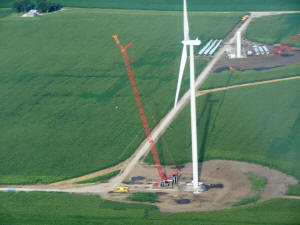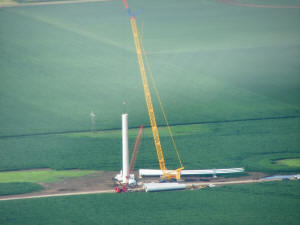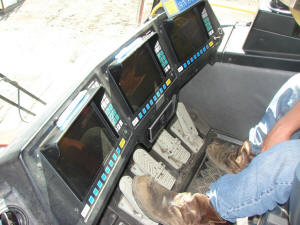|
Monster equipment needed for
taller turbines west of Lincoln
 Send a link to a friend
Send a link to a friend
 [July 25, 2020] [July 25, 2020]
Take a road trip on Route 10 west between Lincoln and New Holland,
look south, and you will see the latest wind farm in Logan County
rising out of the prairie.
This wind farm is called Sugar Creek One.

One done, many to go
at Sugar Creek Wind Farm.
Some of the towers have been completed. Their large 250 foot blades,
still for the moment, but waiting to catch the first wind hundreds
of feet above the ground when the farm goes online.

The ‘little’ crane is
used to assemble the giant of the prairie.
Other towers are in the process of construction with several hundred
feet waiting for another section to be stacked atop them. Next to
each unfinished tower is the one essential element of wind farm
construction, a giant crane that will lift the section into place,
top the tower with the nacelle, and then place the blades in
position.
Wind farms are like all major construction projects, in that they
require many elements to come together to produce the end product, a
jigsaw puzzle on a massive scale.
The cranes are one of those elements, and up close they are almost
too huge for the mind to wrap around. The cranes at Sugar Creek
weigh 11,000 metric tons each.
The cranes on the Sugar Creek project come from a company in North
Carolina. They are built by a company in Germany.
While each element of the wind farm requires machinery to build it,
that machinery is controlled by a skilled operator. The cranes at
Sugar Creek were somewhere else in the country before they came to
Logan County.

Jerry Kitson of the Buckner Crane Company is the person responsible
for moving the giants from project to project. “It takes forty-one
flatbed trucks to move one of these cranes from one construction
project to another. The treads alone are so massive that it takes
two trucks to carry each of them,” he said. Once onsite, Kitson also
is in charge of assembling the crane. “We use a smaller crane to
assemble the big crane. Once all of the parts are here, we can put
it together in about a day and a half,” he said.
Once operational, a skilled crane operator sits in the “cockpit” to
operate it. The word cockpit is apt because it looks like the flight
deck of an airliner.
[to top of second column] |


This is the “cockpit” of the
crane with three multi-function screens that the operator uses to control the
giant.

The crane has three real-time
cameras on it so that the operator can monitor every part.
Chad Johnson from Springfield is one of the Sugar Creek crane operators. He has
been doing this work since 1990. “I am a member of the National Commission for
the Certification of Crane Operators,” he said.
Even though he is a member of the local union, his certification allows him to
go anywhere in the country where his skills are needed.

And what does Johnson have at his fingertips in the control cab? His three
panels tell him what the wind speed is at the top of the boom, how many feet of
boom there are poking into the sky, how much weight is on the boom, how the
custom built engine is operating. By the way, once wind speed exceeds
twenty-eight miles per hour, the crane is shut down.
Johnson has access to three cameras showing a real time view of vital parts of
the crane that he can’t see from his controls. He can “walk” the crane from one
wind tower to another at .85 miles per hour. Each track on the crane has two
motors to drive it, as well as the motor for the crane itself. Chad can have his
hands full.
The cranes at Sugar Creek are the third largest that the German crane company
Liebherr makes. It is almost too much to think about what the next two larger
sizes look like. At $11,000,000 each, every person connected to the crane has to
be topnotch. Buckner Cranes even has three of these giants at the Kennedy Space
Center helping with the Space X project.
The Sugar Creek Wind Farm turbines are the latest generation. They reach higher
than others previously built in the county capturing the precious river of wind
that turns the blades. The crane boom is over four hundred feet in height, while
the wind tower is just short of that. “The next generation of wind towers will
be even taller,” said Kitson. “As we gain altitude, winds get stronger and are
more consistent,” he said.
Taller towers will mean taller cranes.
Drive west and watch the towers being pieced together, watch the delicate dance
of a giant machine with the operator moving a small joy stick carefully stacking
one tower section with precision on top of another. It is an amazing sight.
[Curtis Fox] |